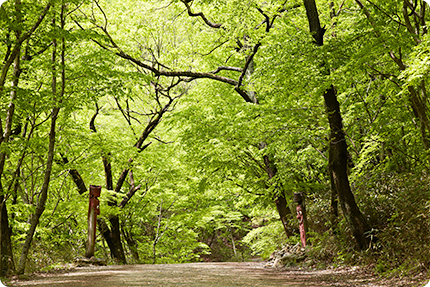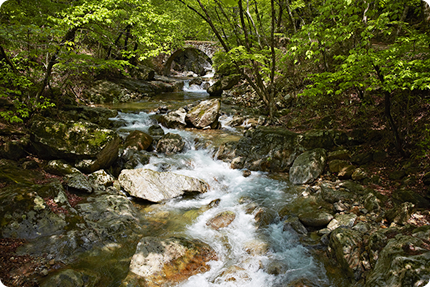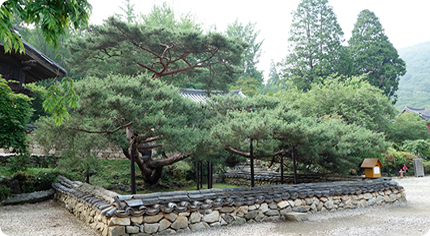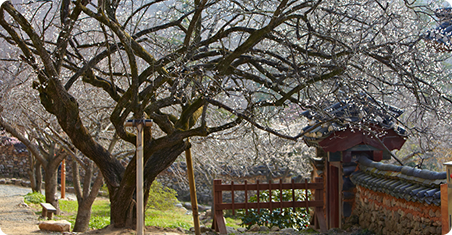Buddhist Mountain Monasteries in Korea
Seonamsa Temple
Seonamsa Temple
Introduction
Natural Environment
History
Temple Layout
Cultural Properties
Information
Natural Environment of Jogyesan Mountain
-
- Jogyesan Mountain (887m) is located on the boundary between Songgwang-myeon and Seungju-eup, located west of Suncheon-si, Jeollanam-do Province.
Seonamsa Temple is situated on the east side of the mountain and Songgwangsa Temple on the west.
Situated at the end of Sobaeksanmaek Mountain Range, the ridges form a hoof shape, centering on Janggunbong Peak, and Jangbalgol flows between the ridges into Boseonggang River.
Jogyesan Mountain is regarded as one fo the three most scenic mountains, alongside Mudeungsan of Gwangju and Wolchulsan of Yeongam, with which it forms a triangle. It offers spectacular scenery throughout the year, and is considered the most breathtaking place among the 8 scenic spots of the former Seungju.
Jogyesan was formerly called Songgwangsan at the time of the founding of Songgwangsa Temple, but it was renamed as Jogyesan when Songgwangsa became the revival bodhi-mandala of the Jogye Order upon its establishment. -
 Seonamsa Forest Trail
Seonamsa Forest Trail
- Jogyesan Mountain (887m) is located on the boundary between Songgwang-myeon and Seungju-eup, located west of Suncheon-si, Jeollanam-do Province.
Seonamsa Temple is situated on the east side of the mountain and Songgwangsa Temple on the west.
Situated at the end of Sobaeksanmaek Mountain Range, the ridges form a hoof shape, centering on Janggunbong Peak, and Jangbalgol flows between the ridges into Boseonggang River.
Jogyesan Mountain is regarded as one fo the three most scenic mountains, alongside Mudeungsan of Gwangju and Wolchulsan of Yeongam, with which it forms a triangle. It offers spectacular scenery throughout the year, and is considered the most breathtaking place among the 8 scenic spots of the former Seungju.
- However, it was originally called Cheongnyangsan. To explain, there were frequent outbreaks of fire at Seonamsa Temple in the Joseon Dynasty and people believed that it was due to the geographical features described as “strong-mountain, weak-water.” Thus, the mountain was given the name, Cheongnyangsan, which contains two of the Sino-Chinese character meaning “water,” as a means to prevent fire.
-
-
 Seungseongyo streams
Seungseongyo streams
- The mountain streams flowing to the east passes through Suncheon and joins Isacheon Stream, flowing into the South Sea, while the streams flowing to the west joins Songgwangcheon Stream.
Because of the high-temperature, high-humidity oceanic climate, it has colloquially been called Sogangnam (“Small River of the South).”
In recognition of the natural beauty of the deep valleys, dense forests, and exquisite waterfalls and springs, it was designated as a provincial park in December 1979. Also, it was chosen as a seed production forest because of the sheer diversity and density of the deciduous forests.
The mountain attracts countless tourists from around the country, who come to visit the famous Seonamsa and Songgwangsa temples and to take in the splendid natural scenery.
-
- As for the natural environment, Jogyesan Mountain has diverse flora thanks to the warm winters and abundant rainfall that are characteristic of the oceanic climate.
According to a study conducted in 1991, there are 750 types of flora including 627 species belonging to 434 genuses, 122 families, 49 orders.
The oak trees in the forests surrounding Seonamsa are typically 40 to 50 years old, and there are also camellia, maple, chestnut and zelkova trees that present breathtaking scenery all year round.
There is a coniferous forest comprised of cedar and cypress trees along the trail between Seonamsa Temple and Daegagam Hermitage and around Seonamsa-jungsu-bi (Seonamsa temple Restoration Monument).
Also, the ginkgo trees distributed on the west side of the temple are rarely seen around other temple sites, and their colorful foliage in the autumn simply take people’s breath away.
Wild tea plantations have been formed on the sides of the entryway from Samindang to Iljumun Gate and in the northern agricultural land. -
 Seonamsa Hinoki Cypress forest
Seonamsa Hinoki Cypress forest
- Notable trees near Seonamsa Temple include Seonammae, designated Natural Monument No. 488, and the 600-year-old Wasong situated in front of Samseonggak that’s the oldest tree in the area in addition to many other old trees including ginkgo trees, Higan cherry, grape myrtle and fir. As such, the buildings and cultural assets as well as the natural environment have been well-preserved in this area.
-
-
 Wasong in front of Samseonggak
Wasong in front of Samseonggak
-
 Seonammae (Natural Monument No. 488)
Seonammae (Natural Monument No. 488)
-
